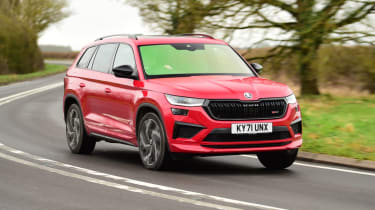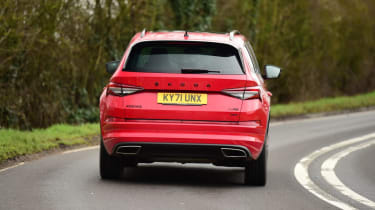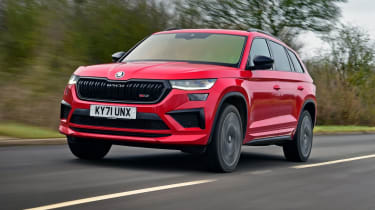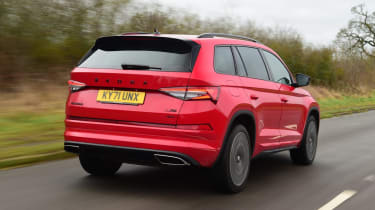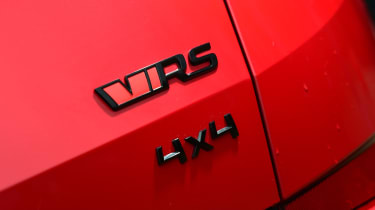Skoda Kodiaq vRS SUV review
"The Kodiaq vRS is fast, but struggles to justify its price and sporty badge"
Pros
- Sporty looks
- Effortless acceleration
- SUV versatility
Cons
- Unjustifiably expensive
- Disappointing economy
- Doesn't feel like a vRS
The Volkswagen Group, whose member companies include Volkswagen, Skoda, Audi and SEAT, has really shown its confidence in creating new market niches in recent years. In 2018, the non-premium high-performance SUV was one of its big new ideas, with a range-topping version of the SEAT Ateca spun off under a new, separate brand as the Cupra Ateca.
Even Skoda, the group’s sensible value-focused brand, now features a flagship Kodiaq vRS, and it’ll shortly launch another: the electric Skoda Enyaq iV Coupe vRS. This side of a Volkswagen Touareg, the Kodiaq vRS is the largest hot SUV in the VW Group stable, and perhaps makes the least sense. The first crack at the Skoda Kodiaq vRS was limited to 300 UK units and discontinued after a year.
 The top 10 fastest SUVs in 2025
The top 10 fastest SUVs in 2025
Putting the much-respected vRS badge on Skoda's biggest family SUV is a bold step; it's hard not to be cynical about whether the Skoda Kodiaq vRS truly deserves the initials that have seen so many enthusiastic drivers become converts to the Czech brand. As if to demonstrate the sporty SUV's worth, Skoda used it to set a new seven-seat SUV lap record of the famous Nurburgring race circuit in Germany. The upshot: the vRS is definitely fast, and it certainly seats seven. But is that enough to make it a must-buy SUV for those who really enjoy driving?
On the face of it, the Kodiaq vRS certainly looks like it has the answers. It stands tall with a more muscular look than lesser models, thanks to its reprofiled front and rear bumpers and the choice of black detailing in place of chrome trim. It also sits on a set of eye-catching 20-inch alloy wheels and generally looks like it means business.
More reviews
After the original version was discontinued in 2020, the Kodiaq vRS returned in 2022 as part of the updated Kodiaq range. Changes include tweaked headlights and a blockier grille that helps the car look more imposing, plus new wheels complete with plastic covers to improve efficiency.
More noticeably, it has returned with a 242bhp 2.0-litre petrol engine, in place of the old car’s 236bhp diesel engine. On paper it’s quicker, taking 6.6 seconds to get from 0-62mph (four tenths faster than before), but the petrol has far less torque than the diesel and this makes it feel like you really have to work it hard to get up to speed.
Rivals such as the Cupra Ateca and Volkswagen Tiguan R are a lot faster off the line, still practical and don’t cost as much as the vRS’s near-£50k asking price. If you’re dead set on speed and seven seats, the Kodiaq’s closest rival comes from within; the SEAT Tarraco is available with the same engine and starts at almost £5,000 less.
Still, speed isn't everything, and the vRS badge has always featured on Skodas that do well when the roads get twisty. In fact, with a clever dynamic chassis control system fitted as standard, the Kodiaq vRS does feel more nimble and sure-footed on a challenging country lane than any other version of the brand's biggest SUV. It can't work miracles, though, and the seven-seater's considerable bulk still takes the edge off its driver appeal. This is not a vRS that'll have enthusiastic drivers itching to leave the motorway in favour of back roads, and the 187bhp petrol Kodiaq in SportLine trim doesn’t feel vastly slower.
With a price that puts the Kodiaq vRS against such premium rivals as the Land Rover Discovery Sport, BMW X3 and Mercedes GLC, and within close proximity to the Mercedes-AMG GLB 35, you'll need to be a big fan to justify choosing the sporty Skoda SUV.
MPG, running costs & CO2
Originally, the Kodiaq vRS came with a relatively sensible diesel engine, although the car’s heft meant it could still only manage 35mpg – barely more than petrol-engined performance SUVs. As part of a wider industry shift away from diesel, the Kodiaq vRS now features a petrol engine.
The petrol vRS can officially return up to 32.5mpg, but unless you spend all your time at cruising speed you’ll be lucky to see more than 30mpg. CO2 emissions of around 200g/km place the Kodiaq vRS in the highest 37% bracket for Benefit-in-Kind (BiK) company car tax, too.
With a list price of comfortably over £40,000, Kodiaq vRS buyers will face an annual surcharge on the first five occasions that annual road tax renewal is due. This brings the annual VED (road tax) total to nearly £500, which drops to the standard rate after year six of ownership.
Speaking of ownership: routine maintenance for a vRS is likely to be priced similarly to any other petrol-powered Kodiaq. However, consumable items such as tyres and brake materials are larger – and will be more expensive – for the vRS than for its less performance-oriented stablemates.
Engines, drive & performance
In order to really justify the steep price that Skoda asks for the Kodiaq vRS, it needs to offer a substantially upgraded driving experience compared to the somewhat less expensive Skoda Kodiaq SportLine. The latter makes no particular claims of high performance, but certainly looks the part with black contrasting details in place of chrome exterior trim, body coloured body sills and chrome exhaust pipes. In fact, take into account the SportLine's 20-inch wheels – the same size as those fitted to the vRS – and only an expert will easily tell the two cars apart.
Previously the Kodiaq vRS was only available with a twin-turbocharged 236bhp 2.0-litre diesel engine. For the facelifted model though, Skoda has introduced the most significant change under the bonnet with a turbocharged 2.0-litre petrol unit replacing the outgoing diesel. It produces 242bhp, and is used in an array of VW Group models including the Volkswagen Golf GTI and the range-topping version of the SEAT Tarraco SUV.
This switch has bestowed the Kodiaq vRS with a 5bhp increase in power and a 6.6 second 0-62mph time - 0.4 seconds quicker than the old car. However, the new engine only produces 370Nm of torque; a significant 130Nm down on the old diesel engine - which means it has vastly reduced pulling power.
While the straight-line speed of the vRS makes it feel quick, the petrol engine needs to be worked harder to get up to speed. It feels more potent at higher revs, which is well-matched with models like the Golf GTI, but in a large seven-seat SUV it doesn’t feel as well suited as the old diesel engine.
Teamed with a mandatory seven-speed dual-clutch DSG gearbox, it’s smooth at lower speeds, and it also feels on the pace if you accelerate hard. But when driving normally in town, a sharp prod of the throttle results in a slight hesitancy from the gearbox with a noticeable jolt before you start off. This trait isn’t unique to the vRS, but it is far more prevalent here than in the lower-powered Sportline model.
The vRS never feels as exciting as its figures suggest, either. In spite of the best efforts of a system called Dynamic Sound Boost that attempts to create a more invigorating exhaust note that is similar to the five-cylinder engine that powers the Aud RS 3. While it adds to the sporty feel of the vRS, it can be fully switched off in ‘individual’ mode.
Should you fancy attacking a series of corners, select the standard Dynamic Chassis Control system to 'Sport' mode. This makes the suspension noticeably firmer, with the effect of further reducing body lean. It does make the vRS slightly more nimble feeling than the Kodiaq SportLine, but it still feels like the large SUV it is. With little feeling of involvement through the steering – despite the vRS having a progressive set-up that adds weight to the steering as speed increases – neither model would be our first choice for a spirited drive on a B-road; with both models being at their best cruising along a motorway.
Interior & comfort
As mentioned above, the less powerful Kodiaq SportLine is something of a thorn in the vRS's side. While the Kodiaq vRS is set apart by more aggressively shaped bumpers, blacked-out window surrounds and mirror caps and, of course, that all-important vRS badge, it still sits at the same height and doesn't look a world removed from its less extrovert stablemate.
It feels a bit more special inside, though – while the SportLine has upholstery in Alcantara, the vRS is distinguished by its leather bolster sections and red stitching. Both models have the Kodiaq's top 9.2-inch 'Columbus' infotainment system, Apple CarPlay and Android Auto, multi-colour LED interior lighting, heated front seats with electric adjustment and memory for the driver, and the vRS gets a 10.25-inch Virtual Cockpit digital instrument panel. Both the SportLine and vRS are available only in seven-seat format.
Practicality & boot space
With seating for seven, the Kodiaq vRS is something of a standalone performance model in the SUV class. This versatility is appealing though, because it comes with no compromises over any other model in the Kodiaq range. With every seat in use, there’s still 270 litres of boot space on offer, which is a similar figure to that of a typical supermini. If you need more than that, dropping the third row of seats frees up a total of 765 litres, and you can fold the second row if you need to carry something really bulky – in this mode there's a massive 2,005 litres of luggage space available.
All but the largest families will be tempted to keep the third row of seats folded down, allowing for a boot as big as most will need, yet reserving the option of creating two more seats if needed. Restricted headroom makes the third row a little uncomfortable for adults, although legroom can be generous if the second row occupants kindly slide their seats forward a little.
In common with other Skoda models, 'simply clever' thinking can be seen throughout the Kodiaq, from the little door edge protectors that deploy when the doors are opened, to the cupholders that hold drinks firmly in place. Overall, the fact that the high-performance vRS is just as flexible in daily use as its less powerful sisters stands very much in its favour.
Reliability & safety
When it comes to owner satisfaction, Skoda has proven something of a force to be reckoned with in recent years ranking highly in the past five years. Back in 2017, the Czech brand managed a second-place finish in our annual Driver Power survey. While 2018 saw Skoda drop to 6th place (out of 26 manufacturers ranked). In 2021 though, the pre-facelift version of the Kodiaq finished 6th out of 75 models in our survey. It was highly rated in almost every section, with strong scores for build quality, practicality, comfort and the infotainment setup; the only area that owners were dissatisfied with was the model's poor fuel economy. This is a very strong result for a brand for which value and practicality is key to its product offering
Among impressive scores tallied up, Skoda returned a better than average overall reliability score in our entire survey, with just 13.7% of owners reporting any faults during the first year of ownership. Owners also praised Skoda's interior design and comfort, practicality and infotainment systems, while engines and gearboxes also came in for positive comments. Among the few areas in which the brand failed to shine were handling and driving excitement.
Safety, meanwhile, is a real Kodiaq strong suit – the SUV was awarded the highest five-star rating by independent crash safety expert body Euro NCAP when it faced rigorous tests in 2017. Adult occupant protection was given a 92% score, and – while its 77% score for child occupant protection is rather lower – it's still a decent result.
Every Kodiaq features autonomous emergency braking (AEB) system and a 'care connect' feature that automatically contacts the emergency services when an airbag is deployed in a collision. You can add lane keeping assist, adaptive cruise control, blind spot detection and traffic sign recognition, as well as high-beam assist.

